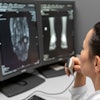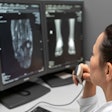 Michael J. Cannavo.
Michael J. Cannavo.
Nostradamus had his quatrains so in the spirit of keeping his spirit alive my predictions for the future will be much the same.
AI
“Men with the power to see inside shall now use words and numbers to determine the fate of those entrusted to them. This reliance on this new data shall continue to grow until it leads them to them failing, requiring these see-ers to once again fall back on the teachings of the past”
No discussion thing can be presented about the future of radiology without a focus on AI. More has been presented on this topic in recent years than all other electronic imaging areas combined.
How much of what is said about AI is real and how much is hype remains open to discussion. There are many pro-AI and con-AI positions but a recent post on X (Twitter) pretty much summarizes the AI market: “There are finally more users in AI than there are experts.” Now before the vendors in the AI market go to DEFCON 1 aiming their missiles at my house I’m just repeating what was said on X. But personally, I believe it is one of the more accurate statements about AI ever made.
A brief background: When AI first was introduced, it was introduced as a product that was better than and would replace radiologists. Needless to say, that didn’t go over very well with the rads. Now that we have more experience with AI in clinical practice (although still extremely limited), we are finding out that is not the case and it probably never will be. The sole exception might be as a first-line review of screening mammography cases (but still reviewed and signed off on by a radiologist) and tuberculosis (TB) screening in third-world countries. I identified these both in 2020 as well. As I said back then, AI will be an adjunct to the radiologist interpretation -- nothing more, nothing less.
Is AI there yet? Not really. As Billy Joel once sang, it’s a matter of trust. As new studies are now finding out, AI has more false positives and false negatives to deal with than initially anticipated. Until radiologists can fully trust AI they will no doubt second-guess its findings and review everything it indicates. That takes time and time is money.
Is having a second opinion even from a machine beneficial? Absolutely. But at what cost? Since the AI findings most times will be included in the final report (only a few AI vendors allow you to exclude this), the radiologist needs to make sure that their interpretation and the AI findings are identical. If AI found something they didn’t, their dictation needs to reflect that. You can rest assured that no report will ever say, “AI found something I didn’t,” any more than it will reflect, “AI indicated a positive that proved to be a false positive.” The one whose signature is on the report is the person who is held accountable. The reality is the AI vendor can’t be sued any more than Microsoft could have been for giving you the blue screen of death in years past. It’s all still on the rad.
A survey was recently done asking how rads felt about it being mandatory for radiologists to use AI in their practices to guarantee patient safety and get paid. The results were divided nearly equally between being AI mandatory and being a choice. One telling comment was “Nobody made other ‘game changers’ mandatory. My PACS will still readily show me the wrong comparison study. Some low balls to fix before mandatory AI.” As such, PACS remains the priority.
Interestingly, as stated before, it is not just reimbursement that will make AI take hold but trust in the technology. This is something several studies have indicated still doesn’t exist within the radiology community.
If you look at it closely many of the strong AI promoters many come from the academic side of the house where cost isn’t nearly as strong a deterrent. It also is home to the harsh reality of the “publish or perish” aphorism so testing AI software and reporting on it is something many of these facilities do as is developing their own algorithms.
Implementing AI also requires an understanding of what AI offers and how to present it. Taking a unique approach to implementing and presenting the technology is crucial and needs to be accepted by both the end users and those on whom the technology is being used to assist. Said another way, it’s not simply about reimbursement.
With 500+ vendors in the AI market, how many will survive? About half will be assimilated in a merger or acquisition with another company with the balance leaving the market primarily due to undercapitalization. This also doesn’t include the AI offerings being developed by several academic facilities and others.
The use of consolidators will be one of the keys to widespread AI use but these costs need to come down dramatically. Integrating AI with PACS also needs to be seamless and unless an end user is willing to accept who their provider has selected as an AI partner a consolidator is the best answer.
PACS/EIS
“And the small shall become the large bringing forth fonts of knowledge from several into one.”
Once the existing on-premise PACS reaches its end-of-hardware life. nearly all larger-scale PACS will be cloud solutions. PACS will also cease to be standalone systems but instead be part of a larger enterprise imaging system (EIS) that includes cardiology PACS, digital pathology, and other clinical systems. As capital budgets have been slashed to the bone SaaS (Software as a Service, aka per-click pricing) will be the preferred payment method over several years. Once again the benefits of a SaaS model have been outlined in several previous articles.
The benefits of the cloud have also been covered in articles over the past few years, but optimizing resources and having a much more reliable system overall are two of the primary advantages. A lot of older technologies like CD burning will fall out of favor with image sharing taking its place. This is already fairly widespread. While several sites still hold on to faxing there will come a time when that simply won’t be an option anymore.
The delineation between PACS vendors will deal more with features and functionality than price, a big change from the decision-making process of the past. Price still has its place but many sites are looking more closely at the impact the system has on workflow than the short-term value provided by a lower initial price.
One change that hasn’t happened yet but one that I anticipate is the lowering of service contract fees. Currently most vendors charge 15% of list price which after five years equates to buying the entire system at least twice over. As over 90% of system support is done internally (or provided by a third party) end users will push back, trying to reduce ongoing PACS operational costs by demanding lower costs for vendor-provided services.
Smaller independent vendors will continue to play a role in addressing the needs of radiology groups servicing smaller hospitals and the outpatient imaging center market, especially in teleradiology scenarios. You also may see a few smaller independent vendors being assimilated into a larger vendor’s products line. Bigger sites will stay with the majors and larger independents. Sadly some of the more successful larger independents will no doubt be bought up by investors or even larger entities (the big three carrier services come to mind) with the end result up for discussion. As often happens when an independent is sold it tends to change the focus of the company from performance to profitability.
Workflow assessment and data standardization take on a much greater level of importance. Companies that offer these services will gain traction, as well as facilities doing internal reviews of their workflow on a much more regular basis.
Networking
“The minions shall pick from the three Gods to bring them together as one, with the smaller gods there to serve the larger”
Most sites will have at least 500 Mbit and optimally 1Gbit virtual private network (VPN) tunnels so that digital breast tomosynthesis (DBT) cases, 1K+ slice CT studies, and others can pass through seamlessly. This includes the transfer of prior images as well, especially important for mammography studies. Unless it isn’t available few sites will have <100 M/bit data lines relying largely on the three major carrier services for high-speed data transfer although local service providers will continue to play a role, especially in smaller cities.
Reimbursement
“Honey will cost much more than candle wax, the price of wheat will be high. The Tesla and other lightning bolts shall take the place of other modes of travel no longer being able to use the gifts of the earth.”
Rads will still make a solid income but requirements for achieving this will no doubt change. Volume will be the name of the game. This requires not just using tools at their disposal but also refining the workflow on a much more regular basis.
Regarding payment, no one can tell what reimbursement will be and for how long it will continue. The New Technology Add-On Program (NTAP) helped jumpstart AI sales for a few select companies and was extended an additional year to help continue AI’s adoption in limited applications. Sadly there are over 500 FDA-cleared AI products within medical imaging, yet less than a handful of these benefitted from programs like this. Current Procedural Terminology (CPT) Category I codes are still a few years out from widespread adoption, although some companies have had success in getting CPT Category III codes that insurers can elect to pay against. These are a set of temporary codes assigned to emerging technologies, services, and procedures.
Once AI gets used more widely and CPT I (mandatory reimbursement) codes are finally issued, the U.S. Centers for Medicare and Medicaid Services (CMS) and private insurers will no doubt adjust payments once they see the speed and efficacy that comes with new PACS software tools and AI use. Again, volume is the name of the game. Hopefully this won’t negatively impact patient care -- reading fast vs accuracy -- but that too remains to be seen. With all the checks and balances in place, patient care should actually improve.
In closing
The closest I get to looking into a crystal ball is my Magic 8 ball but after spending nearly 40 years in the industry you tend to get a good feel on how things will go. Besides my Magic 8 ball has 10 affirmative answers and only five noncommittal or negative ones each, so it would be hard to lose a bet on which direction things will take. I’ll take the odds of a 50% positive outcome any day.
Michael J. Cannavo is known industry-wide as the PACSman. After several decades as an independent PACS consultant, he worked as both a strategic accounts manager and solutions architect with two major PACS vendors. He has now made it back safely from the dark side and is sharing his observations.
His healthcare consulting services for end users include PACS optimization services, system upgrade and proposal reviews, contract reviews, and other areas. The PACSman is also working with imaging and IT vendors to develop market-focused messaging as well as sales training programs. He can be reached at [email protected] or by phone at 407-359-0191.
The comments and observations expressed are those of the author and do not necessarily reflect the opinions of AuntMinnie.com.



















